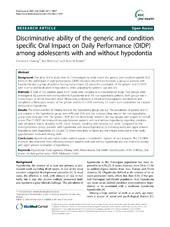| dc.contributor.author | Hvaring, Christina L. | en_US |
| dc.contributor.author | Birkeland, Kari | en_US |
| dc.contributor.author | Åstrøm, Anne Nordrehaug | en_US |
| dc.date.accessioned | 2014-06-20T08:50:37Z | |
| dc.date.available | 2014-06-20T08:50:37Z | |
| dc.date.issued | 2014-05-22 | eng |
| dc.identifier.issn | 1472-6831 | |
| dc.identifier.uri | https://hdl.handle.net/1956/8004 | |
| dc.description.abstract | Background: The aims of this study were to (1) investigate to what extent the generic and condition specific (CS) forms of the oral impact of daily performance (OIDP) inventory discriminate between a group of patients with hypodontia and a group of patients having malocclusion, (2) assess the association of the generic and CS OIDP with severity and localisation of hypodontia, whilst adjusting for patients’ age and sex. Methods: A total of 163 patients aged 10–17 years were included in a cross-sectional study. Two groups were investigated: 62 patients with non-syndromic hypodontia and 101 non-hypodontia patients. Both groups had a malocclusion of similar treatment need. All patients underwent a clinical and radiographic examination and completed a Norwegian version of the generic and the CS OIDP inventory. CS scores were established for impacts attributed to hypodontia. Results: The mean number of missing teeth in the hypodontia group was 6.2. The prevalence of generic and CS oral impacts in the hypodontia group were 64% and 30%, and the corresponding rates in the non-hypodontia group were 62% and 10%. The generic OIDP did not discriminate between the two groups with respect to overall scores. The CS OIDP discriminated strongly between patients with and without hypodontia regarding problems with emotional status, showing teeth, social contact, speaking and carrying out work. Compared to the non-hypodontia group, patients with hypodontia, with severe hypodontia (≥ 6 missing teeth) and upper anterior hypodontia were respectively 3.4, 2.5 and 7.0 times more likely to report any oral impact attributed to small teeth, gaps between teeth and missing teeth. Conclusions: Hypodontia and malocclusion patients report a considerable burden of oral impacts. The CS-OIDP measure discriminated most effectively between patients with and without hypodontia and was related to severity and upper anterior localisation of hypodontia. | en_US |
| dc.language.iso | eng | eng |
| dc.publisher | BioMed Central | eng |
| dc.rights | Attribution CC BY | eng |
| dc.rights.uri | http://creativecommons.org/licenses/by/4.0 | eng |
| dc.subject | Hypodontia | eng |
| dc.subject | Tooth agenesis | eng |
| dc.subject | Missing teeth | eng |
| dc.subject | Malocclusion | eng |
| dc.subject | Oral health related quality of life | eng |
| dc.subject | OHRQoL | eng |
| dc.subject | Oral impact on daily performance | eng |
| dc.subject | OIDP | eng |
| dc.subject | Adolescent | eng |
| dc.subject | Child | eng |
| dc.title | Discriminative ability of the generic and condition specific Oral Impact on Daily Performance (OIDP) among adolescents with and without hypodontia | en_US |
| dc.type | Peer reviewed | |
| dc.type | Journal article | |
| dc.date.updated | 2014-05-31T03:10:56Z | |
| dc.description.version | publishedVersion | en_US |
| dc.rights.holder | Christina L Hvaring et al.; licensee BioMed Central Ltd. | |
| dc.rights.holder | Copyright 2014 Hvaring et al.; licensee BioMed Central Ltd. | |
| dc.source.articlenumber | 57 | |
| dc.identifier.doi | https://doi.org/10.1186/1472-6831-14-57 | |
| dc.identifier.cristin | 1136036 | |
| dc.source.journal | BMC Oral Health | |
| dc.source.40 | 14 | |

